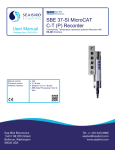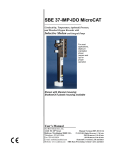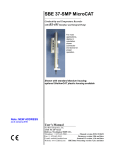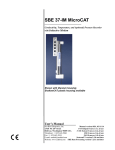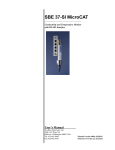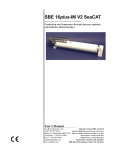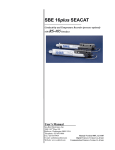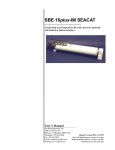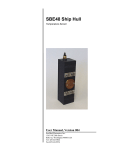Download SBE 37-SM RS-485 MicroCAT Reference Sheet
Transcript
SBE 37-SM (RS-485) MicroCAT Reference Sheet (see SBE 37-SM [RS-485] MicroCAT User’s Manual for complete details) Note: ii in commands is MicroCAT’s user-assigned ID (0 – 99). For example, #01gethd sends gethd to MicroCAT with ID=01. System Setup 1. Install batteries: A. Remove I/O connector end cap: Wipe dry housing/end cap seam. Remove 2 flat Phillips-head screws from end cap. Pull end cap out. Disconnect Molex connector connecting end cap to battery pack. Wipe dry O-ring mating surfaces in housing with lint-free cloth. B. Remove battery pack and install batteries: Loosen captured screw in battery pack cover. Use handle to lift battery pack out of housing. Keep handle upright. Unscrew red cover plate from top of battery pack assembly. Roll 2 O-rings on side of battery pack out of grooves. Insert batteries into battery pack, and roll 2 O-rings into grooves on side of battery pack. Align pin on battery cover plate PCB with post hole, keep handle upright, and screw red cover plate onto battery pack assembly. C. Reinstall battery pack and I/O connector end cap: Align D-shaped opening and notch. Lower battery pack into housing; push gently to mate. Tighten captured screw to secure battery pack in housing. Remove water from O-rings and mating surfaces with lint-free cloth. Inspect O-rings and mating surfaces for dirt, nicks, and cuts. Clean as necessary. Apply light coat of O-ring lubricant to O-ring and mating surfaces. Plug Molex connector together. Fit end cap into housing. Reinstall 2 flat Phillips-head screws to secure. 2. Install I/O cable connector, aligning raised bump on connector side with large pin on MicroCAT. Connect to computer serial port. 3. Double click on SeatermV2.exe. SeatermV2 opens; in Instruments menu, select SBE 37 RS485. Seaterm485 opens. 4. In Seaterm485’s Communications menu, select Configure. In dialog box, select Comm port and baud rate (factory set to 9600). Set ID to Automatically get ID for 1 MicroCAT on line; set ID to Use fixed ID for multiple MicroCATs on line. Click OK. 5. Seaterm485 should automatically connect to MicroCAT. As it connects, it sends #iiGetHD and displays response, and then fills Send Commands window with list of commands for your MicroCAT. 6. Set Date and Time — see Command Instructions and Command List. 7. Set up other parameters if desired — see Command Instructions and Command List. User-selectable sampling modes include: • Autonomous – At pre-programmed intervals, MicroCAT wakes up, samples, stores data in memory, and goes to sleep. • Polled – On command, MicroCAT takes 1 sample and sends data to computer. Useful for integrating with satellite, radio, or wire telemetry equipment. • Serial Line Sync - In response to simple pulse (or single character) on serial line, MicroCAT wakes up, samples, stores data in memory, transmits data (if #iiTxSyncMode=Y), and goes to sleep. Deployment 1. Wiring to MicroCAT – deploy with dummy plug or I/O cable connector installed: • Install dummy plug, aligning raised bump on side of connector with large pin on MicroCAT. Install locking sleeve. OR • Install I/O cable connector, aligning raised bump on side of connector with large pin on MicroCAT. Install locking sleeve. Connect I/O cable connector to computer serial port. 2. Attach MicroCAT to mooring line with Sea-Bird mounting brackets. Data Uploading 1. Connect I/O cable from MicroCAT to computer. 2. Double click on SeatermV2.exe. SeatermV2 opens; in Instruments menu, select SBE 37 RS485. Seaterm485 opens. 3. In Seaterm485’s Communications menu, select Configure. In dialog box, select Comm port and baud rate (factory set to 9600). Set ID to Automatically get ID for 1 MicroCAT on line; set ID to Use fixed ID for multiple MicroCATs on line. Click OK. 4. Seaterm485 should automatically connect to MicroCAT. As it connects, it sends #iiGetHD and displays response, and then fills Send Commands window with list of commands for your MicroCAT. 5. If sampling autonomously (logging), command MicroCAT to stop logging by sending #iiStop. 6. Click Upload menu to upload stored data. 7. Select Convert .XML data file in Tools menu to convert uploaded .xml file to .cnv file for use by data processing software (SBE Data Processing). 8. Process file and review data in Sea-Bird data processing software to ensure all data has been uploaded. Command Instructions Input commands in upper or lower case letters, and register commands by pressing Enter key. MicroCAT sends an error message if invalid command is entered. If new command is not received within 2 minutes after completion of a command, MicroCAT returns to quiescent (sleep) state. If in quiescent (sleep) state, re-establish communications by selecting Connect in Seaterm485’s Communications menu, sending two @ characters, or pressing any key. • For reliable operation, all commands may need to be preceded with two @ characters. Example (status command for MicroCAT 01): @@#01DS Shown on page 2 are the commands used most commonly in the field. See the Manual for complete listing and detailed descriptions. • • • • Reference Sheet Version #011, 09-11-2012; Firmware 3.1 and later 1 Command List CATEGORY Global COMMAND DateTime= mmddyyyyhhmmss GData PwrOff Get Data ID Status General Setup Memory Setup Dataii ID? *ID=ii #iiGetCD #iiGetSD #iiGetCC #iiGetEC #iiResetEC #iiGetHD #iiDS or !iiDS #iiDC #iiBaudRate=x #iiRxDelay=x #iiTxDelay=x #iiDateTime= mmddyyyyhhmmss #iiOutputExecutedTag=x #iiReferencePressure=x #iiInitLogging #iiSampleNumber=x #iiOutputFormat=x Output Format Setup #iiOutputSal=x #iiOutputSV=x #iiOutputDepth=x #iiOutputDensity=x #iiLatitude=x #iiSampleInterval=x Autonomous Sampling (Logging) Polled Sampling Serial Line Sync Data Upload #iiStartNow #iiStartDateTime= mmddyyyyhhmmss #iiStartLater #iiStop #iiTS #iiTSR #iiTSH #iiTSS #iiTSN:x #iiSL #iiSLT #iiSyncMode=x #iiTxSyncMode=x #iiDDb,e #iiGetSamples:b,e Calibration See manual. Coefficients DESCRIPTION Set clock month, day, year, hour, minute, second. Command all MicroCATs to take 1 sample. MicroCATs hold data in buffer until receiving Dataii. Data not stored in FLASH memory. Enter quiescent (sleep) state. Main power turned off, but data logging and memory retention unaffected. Get data obtained with GData. Get MicroCAT ID. Set MicroCAT ID to ii, where ii= 0-99. Command must be sent twice. Get and display configuration data. Get and display status data. Get and display calibration coefficients. Get and display event counter data. Reset event counter. Get and display hardware data. Get and display status. Get and display calibration coefficients. x= baud rate (600, 1200, 2400, 4800, 9600, 19200, 38400, 57600, or 115200). x= delay after MicroCAT receives command until transmitter enabled (1 - 500 msec). Default 25 msec. x= delay after MicroCAT transmits reply until transmitter disabled (1 - 500 msec). Default 25 msec. Set clock month, day, year, hour, minute, second. x=Y: output XML Executed and Executing tags. x=N: do not. x= reference pressure (gauge) in db (used when MicroCAT has no pressure sensor). Initialize logging to make entire memory available for recording. x= sample number for last sample in memory. #iiSampleNumber=0 equivalent to #iiInitLogging. x=0: output raw decimal data. x=2: output converted decimal data in XML. x=1: output converted decimal data. x=3: output converted decimal data, alternate format. x=Y: calculate and output salinity (psu). x=N: do not. x=Y: calculate and output sound velocity (m/sec). x=N: do not. x=Y: calculate and output depth (m). x=N: do not. x=Y: calculate and output density sigma (kg/m3). x=N: do not. x= latitude (degrees) to use in depth calculation. x = interval between samples (6 - 21600 seconds). When commanded to start sampling with #iiStartNow or #iiStartLater, at x second intervals MicroCAT takes sample, stores data in FLASH memory, and goes to sleep. Start logging now. Delayed logging start: month, day, year, hour, minute, second. Start logging at delayed logging start time. Stop logging or waiting to start logging. Send #iiStop before uploading data. Take sample, store data in buffer, output data. Take sample, store data in buffer, output data in raw decimal form (regardless of #iiOutputFormat=). Take sample, store data in buffer, do not output data. Take sample, store data in buffer and in FLASH memory, output data. Take x samples, output data. Output last sample stored in buffer. Output last sample stored in buffer, then take new sample and store data in buffer. x=Y: Enable serial line sync mode. x=N: disable serial line sync mode. x=Y: Transmit real-time data in serial line sync mode. x=N: do not. Upload data from scan b to e, in alternate converted decimal form (#iiOutputFormat=3) (regardless of setting for #iiOutputFormat). Upload data from scan b to e, in format defined by #iiOutputFormat. Reference Sheet Version #011, 09-11-2012; Firmware 3.1 and later 2


